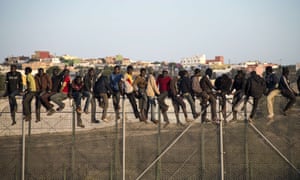Date: Sun, 13 Sep 2015 23:16:00 +0200
Fewer people are scaling the triple layer of barbed wire, but numbers reaching the Spanish territory on the coast of north Africa are rising

The attempts on the fences have stopped. Gone are the pictures of people straddling the wire and the throb of helicopters late at night. Calm seems to have returned to the Spanish enclave of Melilla in north-east Morocco. In the past four months nobody has scaled the barrier, which is six metres high and 11.5km long. The only attempt, early last month, failed before those seeking to reach the European Union could get to the triple layer of barbed wire. “We’re no longer in the headlines for illegal immigration because it isn’t a problem any more,” the leader of the Melilla council, Juan José Imbroda, said in July.
Since January only about 100 people, out of a total of some 3,700 who tried their luck, have entered Melilla by crossing the perimeter fence. Last year they numbered around 2,100, out of 19,000 who tried. This has prompted the Guardia Civil to lend advice to Hungary, which has been fencing off its border with Serbia. The commander of the local detachment, Colonel Ambrosio Martin Villasenor, says vigilance is needed. “It’s a game of chess,” he says.
Madrid has undertaken a range of measures to strengthen the barrier between Morocco and Spain, which is one of the key routes between Africa and Europe. After many people tried to make the crossing in 2014, reinforcements were posted to Melilla, adding to the 650 civil guards already on the ground. Under a controversial new “citizen security” law, which came into force this spring, border guards can send people who do get across back into Morocco, bundling them through small gates in the fence before they can seek asylum.
Lastly, the authorities have added a layer of fine mesh that makes it almost impossible to get a grip on the fence. And the barrier is fitted with sensors and cameras, so contact triggers an alarm in the control room at Guardia Civil headquarters. Units stationed nearby move in quickly.
Moroccan authorities have installed their own barrier, created a ditch, and positioned forces to patrol the perimeter. And it has dismantled camps on Mount Gourougou, where people from sub-Saharan Africa were waiting to cross to Europe, returning there after failed attempts. “The Moroccan police are chasing us,” says Abdullah Baldé, a Guinean aged 20, whom we met outside a temporary holding centre in Melilla.
“They’re using violence to repel migrants and we’re supposed to applaud,” says José Palazon, head of the children’s welfare organisation Prodein. “If silence reigns here, at present, there’s thunder elsewhere. The people pushed back here will try to cross the sea.” Spain is not as exposed as Greece or Italy, but not long ago it, too, had issues with migration.
In 2006, a year after the Socialist (PSOE) government led by José Luis Rodriguez Zapatero announced an amnesty for almost 400,000 undocumented residents, a further 39,000 people were successful in entering the country illegally, mostly via the Canary Islands. Many others perished during the crossing. Last year barely 300 people attempted to reach the Canaries by sea. “The Atlantic route dried up after cooperation with Senegal, Mauritania and Mali, coupled with a combination of land, sea and air patrols,” Villasenor explains. The Zapatero government used a three-pronged approach: surveillance, assisted by the European agency Frontex; cooperation with the police in host countries; and development aid, targeting Senegal, Mauritania and Mali in particular.
It seems unlikely that the Melilla route has been closed for good. There have been fewer attempts along on the perimeter in recent months, but the number of refugees has increased. In 2014 the authorities registered 5,300 entries (across the wire but also by boat, using counterfeit papers or hidden in vehicles). For the first eight months of this year the number was 5,800.
Most of these people hope to reach Germany. Morocco and Spain are just stages on a long journey.